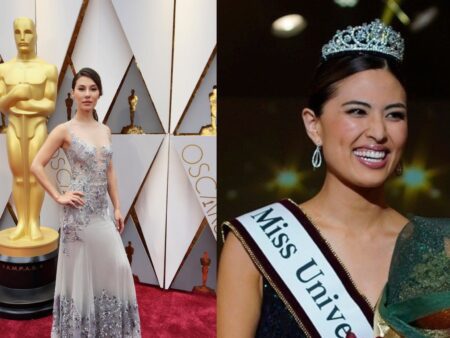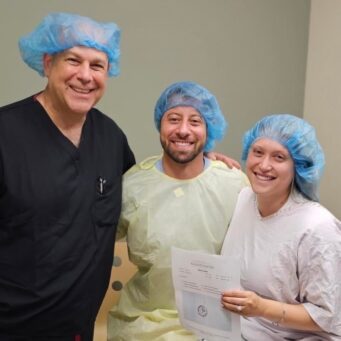
Infertility is a useful trope in movies. It can create dramatic conflict for an otherwise happy couple, offer an excuse for any number of sex scenes, serve as shorthand for the infertile party’s essential goodness or badness. In real life, of course, we’re focused on navigating the tumultuous terrain of fertility treatment: the hours on the phone with insurance, the endless two-week-wait, the tweaking of meds to grow the right number of follicles. It’s somewhat understandable that movie makers would stray from reality in order to make an infertility plotline more entertaining, but, the fact is—some movies do it much better than others.
Here’s what five movies get right about infertility, and what they get (sometimes painfully) wrong:
1. Private Life: IVF, Egg Donation, Adoption
What happens: Intellectual New York couple Rachel and Richard want to start a family, and find themselves up against basically every fertility hurdle imaginable: age (both are in their early 40’s), non-existent sperm, many failed IVF cycles, and a would-be adopted child whose mother goes AWOL as the birth approaches. Eventually, told that they’re unlikely to conceive with Rachel’s eggs, they pursue egg donation with the help of Richard’s step-niece, Sadie.
What it gets right: All of the factors that contribute to Rachel and Richard’s struggles (age, sperm quality, egg count, finances) are, indeed, real issues couples dealing with infertility face. It’s also not uncommon for family members to sometimes help each other by donating eggs, and for this to cause discord with others in the family (Sadie’s mother is not pleased with the egg donation arrangement). What’s more, the movie explores the oft-ignored fact that age isn’t the only factor in play: just because Sadie is young, it doesn’t mean her eggs will be perfect.
Most impressive, though, is the accuracy with which Private Life depicts the strange environment of the fertility clinic, a place both alien and personal, hopeful and tragic. It captures the averted eye contact among couples in the waiting room, the strange intimacy with the staff (“We’re rooting for you!” the receptionist says to Rachel; after one visit to my fertility doctor, a gaggle of nurses gathered by the door to say the exact same thing to me), the glazed look on Rachel’s face as she gets her blood drawn for the umpteenth time.
The movie also nails the strain this process can put on a couple. In one scene, Rachel and Richard get in a heated argument in the brief window they have to try to fertilize Rachel’s eggs. (I can relate: my husband and I would, without fail, get into a screaming fight every time we needed to have “timed intercourse.”) Another highly relatable moment: after an injection, Rachel yelps, “None of the message boards said it was going to hurt like that!” Anyone who has been through fertility treatment knows that message boards are, for better or for worse, a major part of the journey.
Lastly, the movie challenges the “Oh, just adopt!” trope of movies, revealing the truth that adoption is not a fast track to a family, and often involves many challenges of its own.
What it gets wrong: Though there’s some strained conversation about money, the movie doesn’t fully explore how Rachel and Richard have funded so many IVF rounds (the whole process can run up to $30K, and virtually no insurance covers it). In reality, money is one of the biggest factors that shape people’s fertility treatment choices.
Also, when Sadie finds out that her follicles aren’t developing apace, she takes it upon herself to up the dosage of follitropin. While this might, in theory, work, it’s probably not possible in practice: doctors give out these drugs in very precise amounts, and it’s unlikely that Sadie would have access to more follitropin than she’d been prescribed.
2. Baby Mama: IVF and Surrogacy
What happens: Single, career-driven Kate decides she wants a baby, and after several failed attempts to get pregnant using a sperm donor, turns to gestational surrogacy. Through a surrogacy service, she finds Angie, who will carry the embryo created with Kate’s egg and a chosen donor’s sperm.
What it gets right: Though much of the blunt language in this comedy is there for laughs, this directness actually resembles the way that doctors can speak to patients about fertility issues. Kate’s doctor unsparingly lays out her dismal odds of carrying her own child, throwing out the term “advanced maternal age” like an accusation. Fertility doctors often do have to deliver unforgiving news, and it can feel like a painful blow when you’re on the receiving end. (I remember my doctor’s disappointed tone as he muttered, “Honestly, I thought you’d be pregnant by now.”).
The sticky notes around Kate’s house, bearing encouraging phrases like “Yes! Be Fertile!,” encapsulate the psychological maneuvering that can be necessary to manage emotions during fertility treatment: trying to stay positive without getting your hopes up so high that you’re heartbroken each month.
What it gets wrong: As with Private Life, this movie doesn’t adequately grapple with the financial burden of fertility treatment: Kate’s character casually refers to nine cycles with no mention of cost. And it’s not until after those supposed nine cycles that she learns that the shape of her uterus makes conception virtually impossible. In reality, before beginning treatment, a woman (or couple) undergoes a battery of tests to rule out potential problems, so this uterus issue would have been caught long before.
Plus, Baby Mama uses hormonal drugs as shorthand for a character being “crazy.” Sure, taking hormones can screw with your emotions, but it doesn’t make you insane; and besides, if we’re going to talk about the emotional effects of these drugs, we should also mention the other, often more pervasive annoyances they can cause: dry mouth, bloating, fatigue, irritability, etc.
3. Up: Miscarriage
What happens: The opening montage of Up is famously poignant, despite being entirely silent, just about two minutes long, and portrayed in animation. It shows the entire trajectory of a couple’s life, from the first blush of young love to the wife’s death, including the moment where the wife, Ellie, has a miscarriage. After Carl and Ellie and have gotten married and fixed up their house, the next scene shows them happily painting a nursery together, the crib already set up. In the next scene, Ellie sits in a doctor’s office, head in hands, while Carl stands stoically behind her. They never have children.
What it gets right: For all its brevity — seriously, blink and you might miss it — Ellie’s miscarriage scene captures the wrenching sadness of pregnancy loss in a way most films do not. There is no high drama, no shouting or tears, merely Ellie’s quiet devastation at the news and Carl’s attempts to comfort her through his own hurt. When, in the next scene, Ellie sits in the yard alone, silent and with her eyes closed, the movie nails the isolation that can follow a miscarriage. While days before they were working as a team to prepare the nursery, they now must work hard not to withdraw into their own sadness as they cope with the loss.
What it gets wrong: In Up, Carl and Ellie don’t try again to have children after the miscarriage. In reality, miscarriages, though devastating, are incredibly common (they occur in an estimated one in four pregnancies), so for many couples, they’re one of several very difficult steps on the journey to have a child.
4. Juno: Adoption
What happens: When Juno finds herself pregnant at 16, she decides to carry the baby to term and give it to a nice couple. Through an ad, she finds Vanessa and Mark, who are overjoyed at the prospect of adopting Juno’s baby, having found themselves unable to conceive and, like Richard and Rachel in Private Life, burned once by the adoption process.
What it gets right: Vanessa offers a poignant glimpse into the isolation that can accompany an infertility struggle. “My girlfriends tell me that the first couple of months are the hardest,” Vanessa says to Juno, conveying in that one sentence the difficult truth that, when struggling with infertility, you’re often surrounded by pregnant friends and family who share the experience with you. Similarly, when Juno offhandedly says, “You’re lucky it’s not you!” in reference to some pregnancy gripe, the pain on Vanessa’s face belies her polite reaction.
What it gets wrong: Though Vanessa does emerge as a three-dimensional character, the movie begins by relying on the old trope of the infertile woman as uptight, dry, frigid. And when Mark gets cold feet as Juno’s due date nears, his declaration that “It happened so fast!” doesn’t ring true: they’d already been through the adoption process once, and before that had presumably gone through several rounds of fertility treatment, thus giving him months — or more likely years — to get used to the idea.
5. Raising Arizona: Declining Ovarian Reserve
What happens: After H.I. gets out of prison and marries the love of his life Ed, they can’t wait to start a family together. However, after they fail to conceive naturally, and a fertility doctor confirms that it won’t be possible for them to do so, they seek an alternate route to start a family: kidnapping one of five famous quintuplets.
What it gets right: As with Baby Mama, the harsh medical language of the doctor — though, again, exaggerated for comic effect — strikes the right note. Anyone who has sat across from a doctor pointing to a chart with a steep downward line and speaking of “declining ovarian reserve” will feel for Ed as her doctor shows her diagram after diagram explaining why, precisely, she’s “barren.”
The movie also does a good job of showing the ways that infertility can impact other areas of life: Ed loses all interest in anything, quitting her job, withdrawing from H.I., discarding hobbies. (I know that whenever I got a call from my doctor letting me know that our most recent cycle had failed, I wasn’t able to get anything done for the rest of the day.)
What it gets wrong: First, when news breaks that wealthy couple Nathan and Florence Arizona have given birth to quintuplets, H.I. explains that Florence had been taking “fertility pills.” There’s not some magic “fertility pill” — depending on what course of treatment you’re pursuing, there will be a combination of various pills and injections and (yes) suppositories, each of which is designed to create a specific result, not one magic “Have-A-Baby” pill.
The movie also doesn’t address any emotional challenges Ed may have felt in letting go of the notion of carrying her own baby. She treats the prospect of having someone else’s baby as if it were precisely the same thing, without any transitional period to mourn the idea that she would be able to experience pregnancy.
In the 30 years spanned by this list, our collective understanding of — and willingness to acknowledge — infertility has come a long way. Of course, no matter how cinematic depictions of infertility evolve, no movie will ever perfectly capture an individual’s experience, because each fertility journey is wholly unique. Still, if onscreen portrayals of infertility continue to become more true-to-life, they offer a much-needed way for women (and men) in this process to feel less alone.
Contributor
Kate Willsky
Kate Willsky is a freelance writer based in Sacramento via Brooklyn via San Francisco. Her work has appeared in SELF, Eater, Vice, and Food52, among other publications. After a year of fertility treatment, she’s expecting her first child this spring.

Listen to stories, share your own, and get feedback from the community.


















